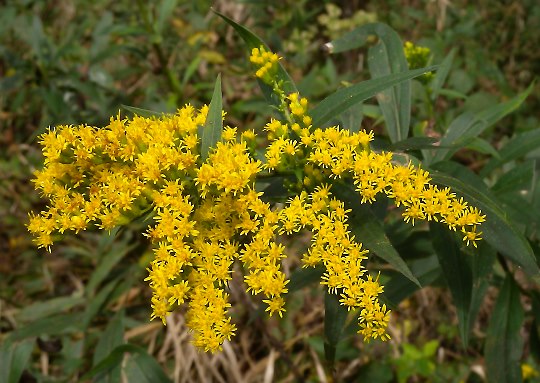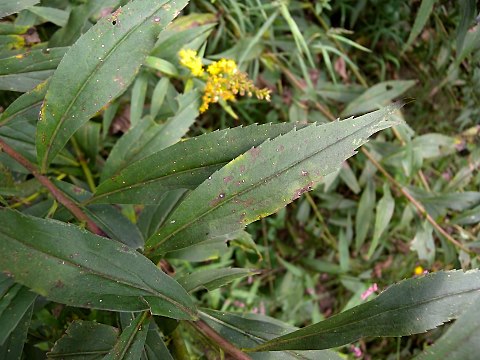Description: This perennial wildflower is 3-7' tall and largely unbranched, except at the apex, where the flowering stalks occur. The central stem is light green or pale purple, terete, glabrous, and sometimes glaucous. The alternate leaves are 3-5" long and 1/3–2/3" (8-17 mm.) across, becoming only slightly shorter while ascending the central stem. Sometimes there are leafy lateral stems that develop from the leaf axils of the central stem, but they are very short and insignificant. The alternate leaves are narrowly lanceolate to elliptic, slightly to sharply toothed along their margins, and sessile; each leaf tapers gradually towards its tip and base. The upper surfaces of the leaves are medium to dark green and glabrous, while their lower surfaces are a slightly lighter shade of green and glabrous or nearly so (sometimes there are fine hairs along the major veins below). Each leaf has 3 veins (a central vein and 2 lateral veins) that are nearly parallel to each other.

The central stem
terminates in a panicle of flowerheads up to 1' long and 1' across.
There is some variability in the shape and size of the panicle across
different populations of plants. Individual branches of the panicle are
light green, slightly to moderately pubescent, and recurved. There are
usually some leafy bracts along the branches of the panicle; these
leafy bracts are similar to the leaves, except they are smaller in
size. Individual flowerheads are a little less than ¼" across,
consisting of about 7-15 yellow ray florets and 5-11 yellow disk
florets. At the base of each flowerhead, there are appressed floral
bracts in 2-5 overlapping series; individual floral bracts are
linear-lanceolate in shape. The blooming period occurs from late summer
to early fall for about a month. Both ray and disk florets produce
small achenes with sessile tufts of hair. The achenes are
bullet-shaped, flat-topped, and finely pubescent. The root system is
fibrous and rhizomatous. Colonies of plants are often formed from the
rhizomes.
Cultivation:
Giant Goldenrod prefers full sunlight to light shade, wet to moist
conditions, and soil consisting of loam, clay-loam, sandy loam, or
silty loam. It tolerates temporary flooding during the spring. In
cultivation, some plants may lean over during the blooming period
because of their height.
Range & Habitat:
The native Giant Goldenrod is occasional to locally common throughout
Illinois.
However, some decline in populations across the state may have occurred
from habitat destruction. Habitats include openings in floodplain
woodlands, borders of woodlands, low partially shaded areas along
rivers and ponds, riverbottom prairies, wet prairies, prairie swales,
soggy thickets, fens, and ditches. The preceding list includes both
sandy and non-sandy habitats. In general, Giant Goldenrod is an
adaptable plant with low fidelity to any particular habitat. Its main
requirement is the availability of adequate moisture.
Faunal Associations:
The nectar and pollen of the flowerheads attract many kinds of insects,
including bumblebees, long-horned bees (Melissodes, Svastra), Halictid
bees,
dagger bees (Calliopsis, Heterosarus), Andrenid bees, Syrphid flies,
and wasps. Other insects have been observed to feed on the leaves and
other parts of Giant Goldenrod. These species include several leaf
beetles, specifically: Brachypnoea margaretae, Exema
canadensis, Microrhopala vittata, Ophraella
conferta, Ophraella sexvittata, Paria
thoracia, Sumitrosis inaequalis, Trirhabda
borealis, Trirhabda canadensis, and Trirhabda
virgata. Other insect feeders include Neokolla
hieroglyphica (Leafhopper sp.), Publilia modesta
(Treehopper sp.), Uroleucon rudbeckiae (Aphid sp.),
Corythucha marmorata (Goldenrod Lace Bug), and Eurosta
solidaginis (Goldenrod Gall Fly). The larvae of a beetle, Mordellistena
unicolor (Goldenrod Gall Beetle), prey upon the maggots of
the Goldenrod Gall Fly. The caterpillars of many Noctuid moths,
Geometer moths, Tortricid moths, and Gelechiid moths feed on the
flowers, developing seeds, pith of stems, and roots. Vertebrate animals
also use Giant Goldenrod and similar species as a source of food. The
Ruffed Grouse and Prairie Chicken eat the leaves and flowerheads, while
the Indigo Bunting, Common Goldfinch, Swamp Sparrow, and Slate-Colored
Junco eat the seeds. Mammalian herbivores that feed on the leaves
and/or stems include the Cottontail Rabbit, White-Tailed Deer, Meadow
Vole, and Muskrat. Because this tall goldenrod often forms colonies of
plants, it provides some cover for wildlife.
Photographic Location:
Along a path in a moist thicket at Fox Ridge State Park in east-central
Illinois.

Comments: This wildflower is sometimes referred to as Solidago serotina (Late Goldenrod). It is a tall and columnar plant. Several varieties of Giant Goldenrod have been described, but they are difficult to differentiate. Because of its 3-veined leaves, this species can be confused with Solidago canadensis (Canada Goldenrod), except the latter species has hairy stems and it tends to be slightly shorter. Another goldenrod with 3-veined leaves, Solidago missouriensis (Missouri Goldenrod), has hairless stems like Giant Goldenrod. However, Missouri Goldenrod can be distinguished by its shorter stature (rarely over 3' tall), earlier blooming period, and the lack of fine hairs along its flowering branches. Sometimes Solidago spp. (Goldenrods) hybridize, producing plants with mixed characteristics that are difficult to classify.